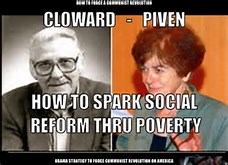I remembered this post from nearly eleven years ago when I responded to a readers comment just now.
Of course, I’ve been saying that gnashing our teeth about how we got here (in chaos) is likely a waste of time at this point when we need to be devoting our full attention to getting Trump re-elected and saving our economy and our selves! Nevertheless, this might be a useful reminder of the Left’s goals in adding more and more poor black and brown people to American towns and cities.
Full text (November 2009):
If you are a regular reader, you know one of the themes we have been writing about is what I call “community destabilization,” we have a whole category for those posts, here. And, you know we write about the Cloward-Piven strategy as part of that discussion.

Cloward and Piven, while professors at Columbia University (Obama’s alma mater), penned a 1966 treatise in Nation magazine in which they outlined a strategy to bring about a revolution in America.
I wrote about it most recently, here. Simply stated the strategy involved flooding the welfare system with so many impoverished people that the system would collapse and that would pave the way for a new form of government—a government that would redistribute the wealth and provide a guaranteed income for everyone.
Below is another shocking segment from that article. We are often lectured about what is the moral thing to do about refugees, but let me ask all of you, what is moral about this Far Left strategy?
Remember immigrants and refugees are today’s poor. As unfashionable as the word is, frankly, I call this strategy to place as many people as possible on the welfare system and use them for promotion of a radical political ideology downright evil.* (Emphasis below mine)
To generate an expressly political movement, cadres of aggressive organizers would have to come from the civil rights movement and the churches, from militant low-income organizations like those formed by the Industrial Areas Foundation (that is, by Saul Alinsky), and from other groups on the Left. These activists should be quick to see the difference between programs to redress individual grievances and a large-scale social-action campaign for national policy reform.
Movements that depend on involving masses of poor people have generally failed in America. Why would the proposed strategy to engage the poor succeed?
First, this plan promises immediate economic benefits. This is a point of some importance because, whereas America’s poor have not been moved in any number by radical political ideologies, they have sometimes been moved by their economic interests. Since radical movements in America have rarely been able to provide visible economic incentives, they have usually failed to secure mass participation of any kind. The conservative “business unionism” of organized labor is explained by this fact, for membership enlarged only as unionism paid off in material benefits. Union leaders have understood that their strength derives almost entirely from their capacity to provide economic rewards to members. Although leaders have increasingly acted in political spheres, their influence has been directed chiefly to matters of governmental policy affecting the well-being of organized workers. The same point is made by the experience of rent strikes in Northern cities. Their organizers were often motivated by radical ideologies, but tenants have been attracted by the promise that housing improvements would quickly be made if they withheld their rent.
Second, for this strategy to succeed, one need not ask more of most of the poor than that they claim lawful benefits. Thus the plan has the extraordinary capability of yielding mass influence without mass participation, at least as the term “participation” is ordinarily understood. Mass influence in this case stems from the consumption of benefits and does not require that large groups of people be involved in regular organizational roles. [Of course not, the smart people, the elite radicals, would call all the shots!]
Moreover, this kind of mass influence is cumulative because benefits are continuous. Once eligibility for basic food and rent grants is established, the drain on local resources persists indefinitely. Other movements have failed precisely because they could not produce continuous and cumulative influence.
When you read the Nation article, note that Cloward and Piven were very conscious of the concept of the ‘presumption of good intentions.’ In other words, they knew that this political strategy would go undetected for a very long time because it would be hidden from their average do-gooder minions by the presumption that this was all about aiding the downtrodden.
I must say this ‘strategy’ is the only logical explanation for why we are still pouring refugees into the US right now when there is little or no work for them and they are being “warehoused” in decrepit apartment buildings, like those in Bowling Green, KY. Incidentally, even if refugees have chicken plant jobs they still receive various forms of public assistance because the meatpackers no longer pay a living wage.
I wonder did Cloward and Piven ever anticipate the involvement of big businesses as allies in the revolution? See this post from August in which I list strange bedfellows on the open borders issue.
* I have to laugh, after I posted this, I see that Ann Coulter also suggested Far Left Liberal strategies were “evil” when she said their motto is:
